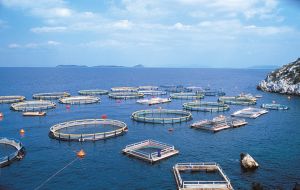MercoPress. South Atlantic News Agency
Booming world fish trade generating more wealth than ever, says FAO report
 Aquaculture production is estimated at 67 million tons in 2012 and 70 million tons for 2013
Aquaculture production is estimated at 67 million tons in 2012 and 70 million tons for 2013 The booming world fish trade is generating more wealth than ever before, but countries must help small-scale fishers and fish farmers benefit too, says FAO.
Global fishery production from wild capture fisheries and aquaculture is expected to set a new record in 2013 at 160 million tons, up from 157 million tons the previous year, while exports will reach 136 billion dollars, according to preliminary data published ahead of the FAO Sub-Committee on Fish Trade meeting in Bergen, Norway, next week.
“The record trade figures reflect the strong growth in aquaculture output and the high prices for a number of species such as salmon and shrimp,” said Audun Lem, Chief of FAO’s Products, Trade and Marketing Branch. “This is underpinned by firm underlying demand for fish products from world markets.”
Aquaculture production is expected to hit about 67 million tons in 2012 and projections for 2013 point towards fish farmers producing 70 million tons – 44% of total fishery output and 49% of fish for direct human consumption.
“The proportion of fish production being traded internationally is significant, at around 37% in 2013,” said Lem. “This makes the fisheries sector one of the most globalized and dynamic industries in world food production.”
Developing countries continue to play a major role in supplying world markets, accounting for 61% of all fish exports by quantity and 54% by value in 2012. Their net export revenues (exports minus imports) reached 35.3 billion, higher than those for other agricultural products combined including rice, meat, milk, sugar and bananas.
But benefits from international trade are not always trickling down to small-scale fishing communities, even though small-scale fishers and fish farmers constitute about 90% of the sector’s global workforce, FAO said.
The Organization is urging countries to assist small-scale fishers and fish workers – around half of whom are women – to overcome a number of barriers such as lack of bargaining power and access to credit, difficulty in meeting market access regulations and poor trade-related infrastructure, so that they can access local, global and especially regional markets.
“There are exciting opportunities in regional markets at the moment as emerging economies such as Mexico, Brazil, Indonesia and Malaysia want more fish and are looking to their neighbors to supply it,” Lem said. “At the same time, this growing demand is stimulating new investments in local aquaculture production, including in Africa.”
Countries need to provide small-scale fishers with access to finance, insurance and market information, invest in infrastructure, strengthen small-scale producer and trader organizations, and ensure that national policies do not overlook or weaken the small-scale sector, according to FAO.
As greater quantities of fish are processed for export, more by-products such as heads, viscera and backbones can potentially be turned into valuable products also for human consumption, FAO said.
“We must ensure that these by-products are not wasted from an economic but also a nutritional point of view,” Lem underlined. “By-products often have a higher nutritional value than fillets, particularly in terms of essential fatty acids, vitamins and minerals, and can constitute an excellent means of combating micronutrient deficiencies in developing countries.”
New markets for by-products are already opening up, he said, noting growing demand for fish heads in some Asian and African markets, while there is also potential to use fish heads and bones to meet the rising global demand for fish oil and mineral supplements.
Greater potential also exists to use by-products to make the fishmeal and fish oil used as feed in aquaculture and for livestock, indirectly contributing to food security, according to FAO. This would allow some of the whole fish utilized today for meal and oil production to be used for direct human consumption.




Top Comments
Disclaimer & comment rulesCommenting for this story is now closed.
If you have a Facebook account, become a fan and comment on our Facebook Page!